

Dan Pupius is Co-founder and CEO of Range — a software company that’s designing tools to help teams check-in async, run more effective meetings, and feel more connected.
He has an MA in Industrial Design from Sheffield Hallam University and a BSc in Artificial Intelligence from the University of Manchester. Before Range, he was Head of Engineering at Medium and a Staff Software engineer at Google.
More isn’t always better, especially when it comes to meetings.
In case you need convincing, check out the results of this Harvard Business Review survey of 182 executives:
- 71% of respondents described meetings as “unproductive” and “inefficient”
- 65% said that meetings limit their ability to get work done
- 64% said that meetings interfere with deep thinking
- 62% said that meetings don’t bring teammates closer together
Looks like meetings are missing the mark. Not to mention, meeting overload seems to have only gotten worse with the pandemic. 😬
Luckily, meetings aren’t the only way to touch base with your team and understand how work is progressing day-to-day. This is where ClickUp and Range can help.
Managing and promoting asynchronous work
Don’t get me wrong— I know how important it is for teammates to connect frequently and stay on the same page. I’m not saying that your team needs to avoid meetings altogether, but it’s important for us all to take a thoughtful approach to team communication so we can create space for focus time and make the meetings we do have better.
Last year, I actually had a conversation with ClickUp CEO Zeb Evans about how tough it can be for teams to tap into their full potential during the work day. We realized both ClickUp and Range are helping teams lean into asynchronous communication so they can cut down on busy work, streamline their meeting load, and make the most of their work time.
In this article, I’ll walk through the basics of Range and how your team can use it with ClickUp not just to stay up to date on how work is progressing, but also to check in on how everyone’s doing along the way.
Let’s dive in.
How Range works
To kick things off, here’s an overview of how Range helps teams feel more connected and in sync.
Range empowers remote and hybrid teams to check in asynchronously, run effective meetings, and connect on a personal level day to day. My co-founders and I launched Range because we were tired of meeting-heavy schedules that didn’t actually bring us closer to our teammates around the world.
Human tools for remote work
At Range, we believe the human side of work is just as essential as productivity.
We’ve been building a suite of tools for written check-ins, meeting facilitation, and more so teams can feel in sync while they work—all while striking a manageable balance between async and real-time communication.
Check-ins for the win
At the core of Range are Check-ins—asynchronous updates on work and how you’re doing. You’re probably used to hearing the term “check-in” at an airport, hotel, or ticketed event. But when we talk about Check-ins, we’re talking about a written version of a standup meeting that helps teams share valuable info on a regular cadence. We think async Check-ins are important for a few reasons:
Check-ins make it easier to cut down on pointless meetings
Since Check-ins only take ~5 minutes to write, they’re a quick and effective way for teams to stay in the know about how everyone’s doing and what they’re working on. No need to schedule a status meeting if you can share that info asynchronously. Plus, Range reminds your team when to check-in, so you can build a routine around sharing updates, even without a meeting on the calendar.
Check-ins help teams connect to the human side of work
People are so much more than the work they do. Building a habit of sharing not just what you’re working on but also how you’re doing is a great way to strengthen feelings of trust and connection on any team. Range Check-ins make it simple to weave answers to mood-sharing and icebreaker questions into work updates, so everyone feels more connected.
Check-ins surface the info that matters most
Day-to-day communications can get overwhelming. Nowadays, there are so many ways to reach out to our teammates—from Slack DMs to comments in shared docs–it’s hard to make sense of it all. 😵
With Range Check-ins (unlike email), it’s easy to flag blockers and FYIs, highlight learnings, share how you’re feeling, and pull in context from other tools so everyone can stay on top of what’s really important.
Anatomy of a Check-in:
Step 1: Share your mood to give your team useful context and foster deeper connections
With a color and an emoji, you can quickly capture how you’re doing. We use a green, yellow, and red color scale.🚦
- Green: Feeling good. Focused, excited, or relaxed. You’re ready to take on the day ahead
- Red: Feeling distressed, unsettled, or iffy. You’re struggling to concentrate, and you don’t feel ready to take on the day
- Yellow: Somewhere in the middle. Maybe you’re tired or distracted and you aren’t sure how your day is going to go
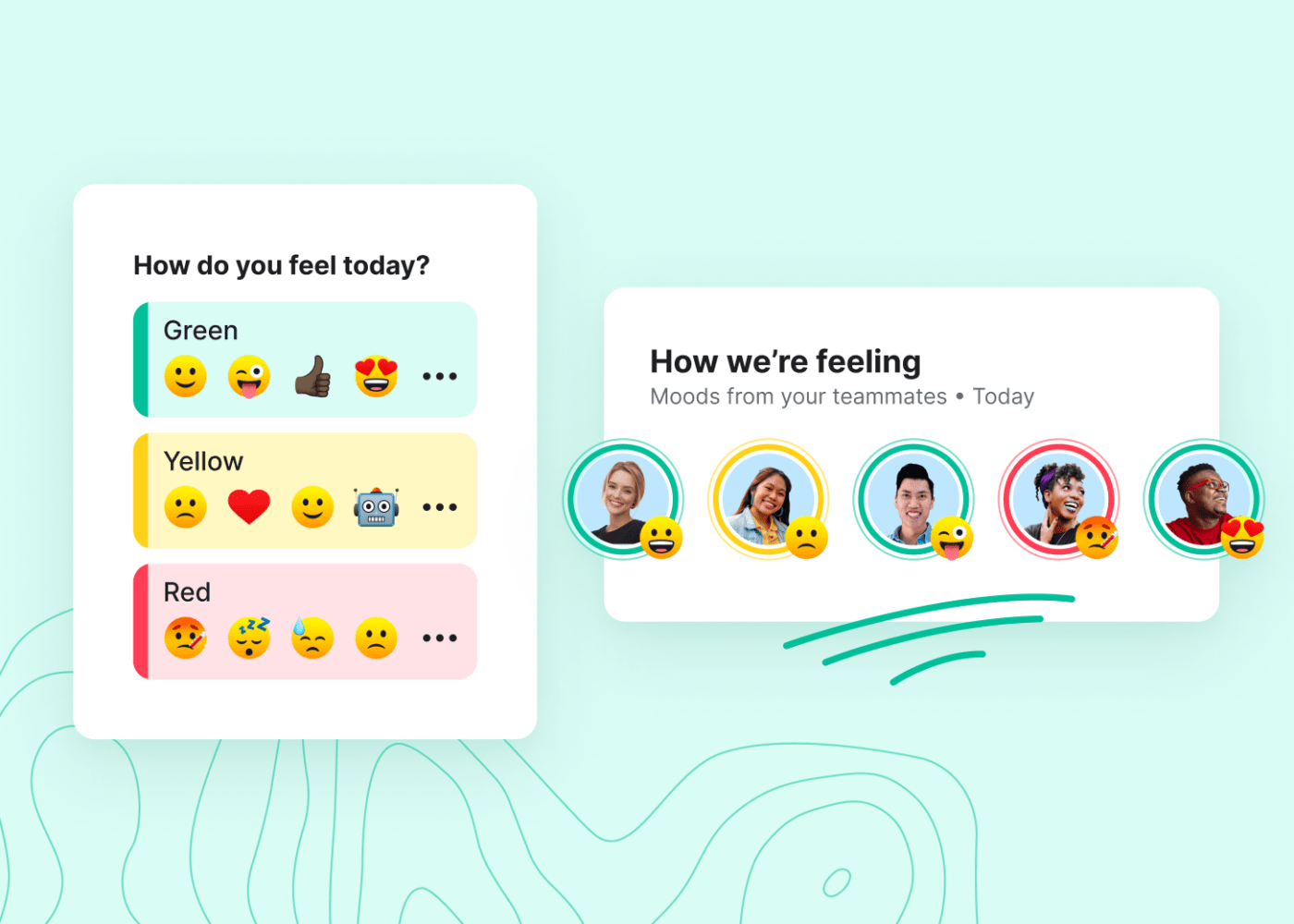
Step 2: Publish your plan for the day so your teammates know what you’re focusing on across all your tools
Collaboration gets a whole lot easier when your team can see what’s on your plate. Sharing your planned work gives your team a chance to react, ask follow-up questions, and share ideas to help your day-to-day tasks run as smoothly as possible. You can drag and drop work items from tools like Google Docs, GitHub, (and, of course, ClickUp!) to quickly add context to your check-in, without having to rewrite tasks.

Step 3: Highlight what happened since the last time you checked in so your whole team has visibility into recent progress
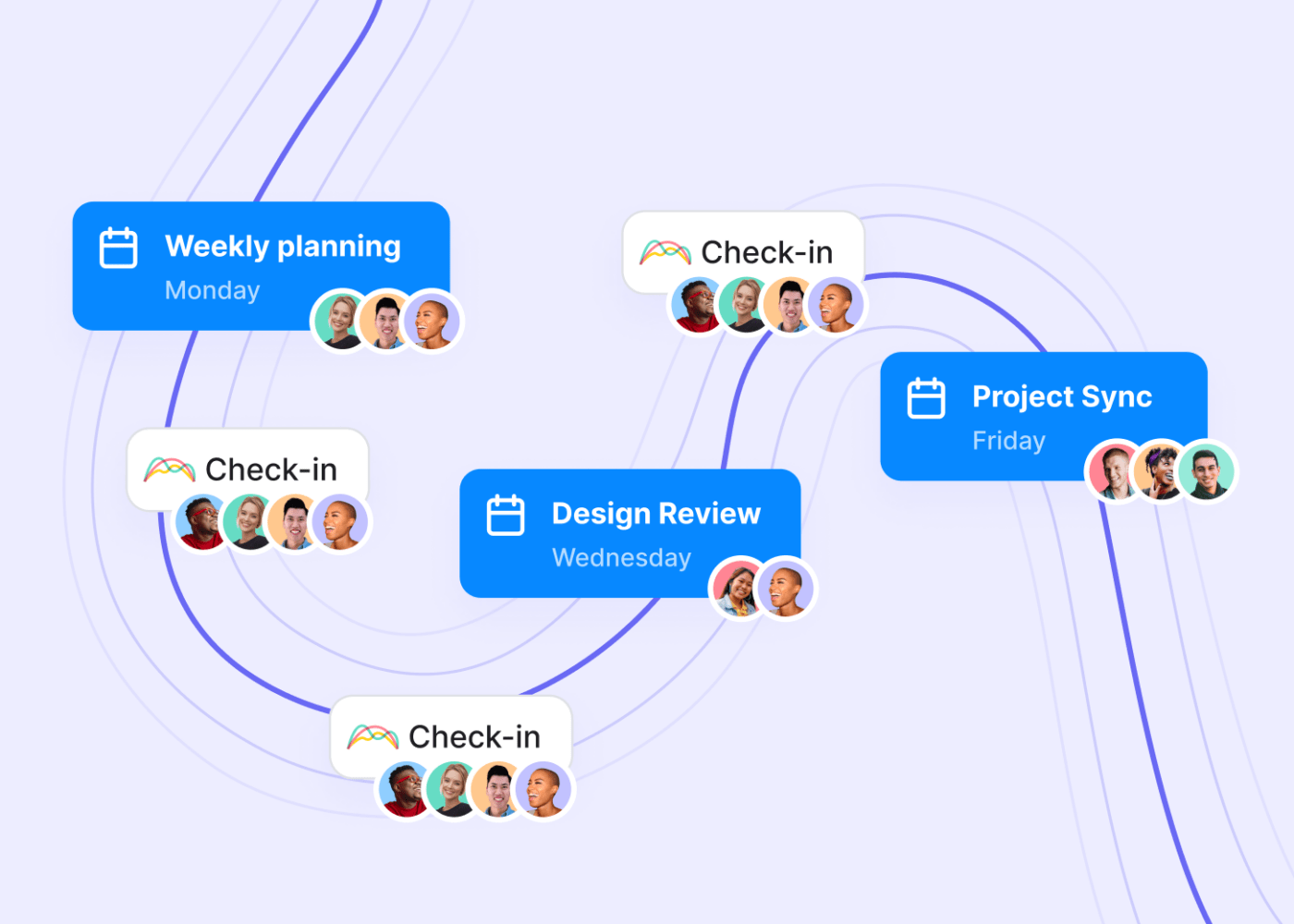
Step 4: Answer a team question to lean into the human side of work and let your personality shine
Icebreakers like “How would you describe your communication style?” or “What TV show did you love as a teenager?” are a great way to get to know your teammates over time and strengthen feelings of trust.

You don’t always have to schedule a meeting to get a pulse on how someone’s doing, how they’re feeling, or how you can collaborate with them. Asynchronous Check-ins help you stay on top of how your team’s faring day to day, without cutting into everyone’s focus time.
⭐️ Bonus: Since Range integrates with ClickUp, it’s a super-easy tool for ClickUp users to build into their workflow.
How ClickUp and Range work together
When it comes to teamwork tools, there are a lot of fish in the sea, but Range and ClickUp are a pretty great match. 💘
While Range helps teams share quick check-ins on their work and how they’re doing, ClickUp equips teams with comprehensive project management functionality. Teams using ClickUp save a day each week by tracking and assigning all their work in one place. 🙌
TL;DR: You can track all your team’s work in ClickUp 📈and build a simple async check-in routine with Range. 🔄
By popular demand, the Range team built an integration with ClickUp this past fall, so teams could more easily stay connected. Now, organizations can leverage the power of both tools to simplify the work day and focus on what’s most important: running happy effective teams.
Here’s an overview of how teams can use Range and ClickUp together for a simpler, more connected way to work:
Build a foundation of async communication
As we’ve discussed, meetings aren’t the only way to manage day-to-day work on a team. They’re useful for tackling stickier topics, arriving at decisions that require a lot of back-and-forth communication, and aligning on the “why” behind a new project.
If you’re collaborating with folks across your organization, you can’t expect to be in regular meetings with everyone. Even if that were an option, it wouldn’t be the most effective use of your time.
To keep teammates on the same page (especially if folks are absent, focusing on different work streams, or working in different time zones) you need written records of what’s happening. I like to call this “building a foundation of async communication.”
Together, ClickUp and Range provide an async foundation that’s manageable and enjoyable for your whole team
| ClickUp | Range |
|---|---|
| From Tasks and Docs to project timelines and mind maps, ClickUp has everything you need to manage your team’s tasks so everyone can keep tabs on team progress in one place | Range makes it easy for teams to check in asynchronously. Share how you’re doing, answer team-building questions, and comment on your day-to-day tasks to connect the human side of work to the work side of work |
Pull ClickUp activity into Range Check-ins
It only takes a few minutes to link your Range and ClickUp workspaces.
Once you activate the integration, your ClickUp Tasks and other activity will automatically appear in your Range sidebar, so you can drag and drop them into your Check-ins.
Unlike writing a status update via email or prepping to give verbal updates in a meeting, sharing an async Check-in takes less than five minutes.
Add ClickUp activity directly into your Check-ins so you can avoid busy work (like summarizing tasks) and focus your energy on what’s most important, getting the help you need, sharing reflections and takeaways, and connecting with your teammates.
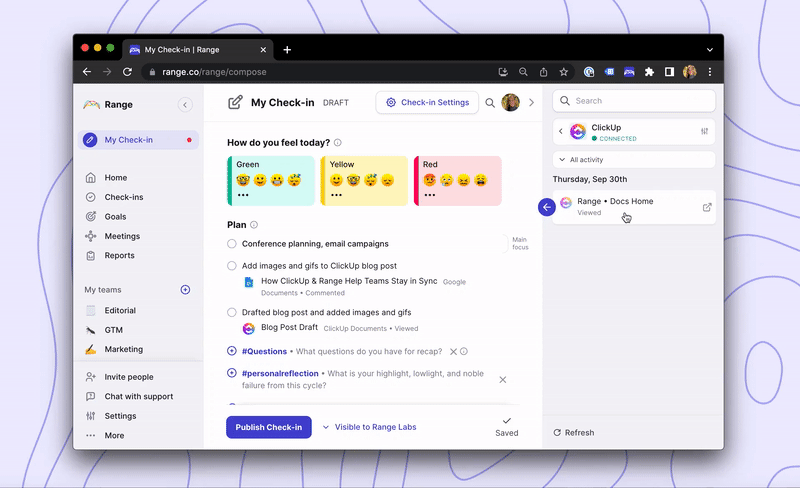
Use flags, tags, and reactions to celebrate your teammates
Once you pull ClickUp tasks into your Check-in, you can add flags and tags to draw items to your team’s attention. Maybe you want to celebrate a recent milestone, thank a teammate for their help on a task, share something you learned, or kick off a discussion. Here are some examples:
- Help
- Celebrate
- Thanks
- Milestone
- Learning
- FYI
- Feedback
- Discuss
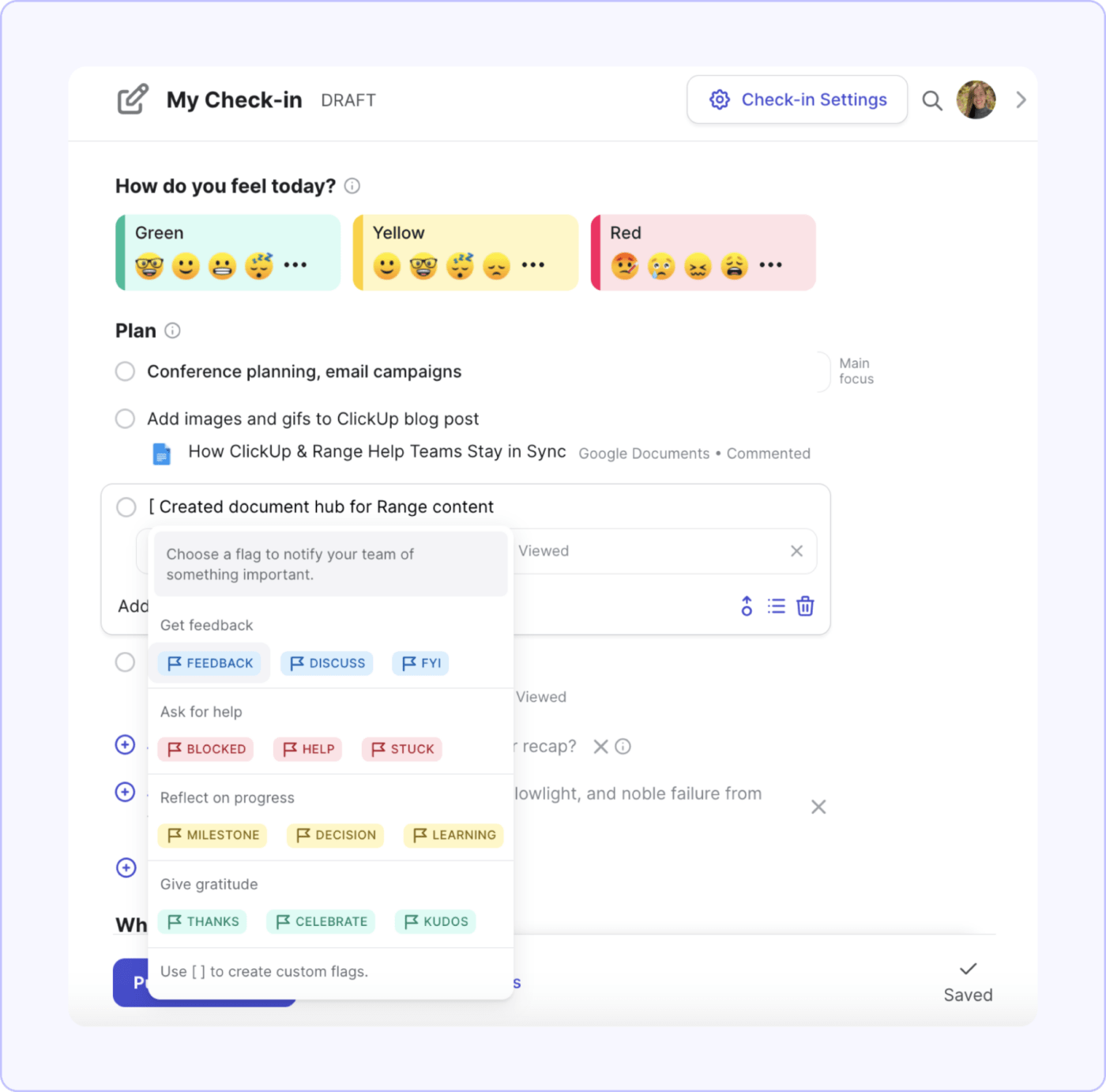
You can also react to your teammates’ Check-ins to show your gratitude. Let’s say an engineer ships a bug fix, and they include a completed ClickUp task in their Check-in. Add emojis and comments to celebrate their work and keep the good vibes flowing. 🙌
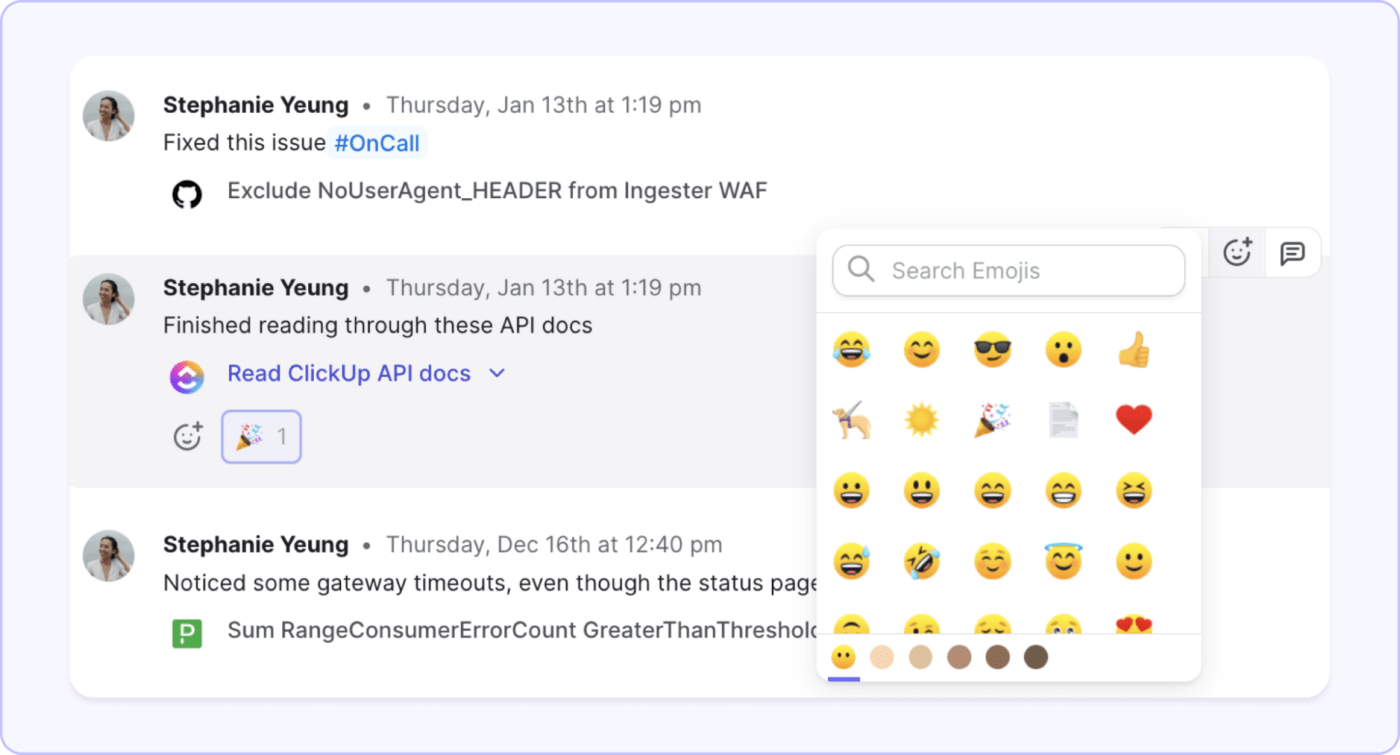
⭐️ Note: Expressing gratitude at work isn’t just a nice-to-have. It increases job satisfaction which keeps teams feeling productive and cohesive, even during difficult times.
Integrate with Slack for an even more streamlined experience
If you’re a Slack user and would rather run Check-ins in your team’s existing communication channels, look no further than the Range app for Slack. You can pull in ClickUp tasks as attachments, share how you’re doing, answer icebreaker questions, and add comments, all from the comfort of your Slack workspace.
What’s possible with ClickUp and Range
We chatted with some folks who use ClickUp and Range day to day. Here are some examples of what’s possible when teams combine ClickUp’s powerful project management tools with async Check-ins in Range:
Case Study 1: Collaborating virtually to build a more sustainable future
A graduate of Stanford d.school, David Cutler, founded Fortuna Cools with an ambitious mission: to replace foam packaging with natural fibers. He works closely with coconut farmers and local manufacturers in the Philippines to repurpose leftover coconut husks into insulation products that outperform conventional plastic coolers. David and his team use ClickUp and Range to stay on the same page while working virtually.
David says that for the Fortuna Cools team, ClickUp is a “master project management tool. The idea is for ClickUp to be the source of truth.” They use Range to publish daily Check-ins that share how they’re doing and what they’re working on, pulling in ClickUp tasks to make those updates more efficient and contextualized.
He says, “Range captures the day-to-day priorities. It’s a bite-sized and visible way to think about the short-term stuff.”
Case Study 2: Running high-performing digital marketing agencies from anywhere
For fast-moving marketing agencies, ClickUp and Range are a dynamic duo that helps everyone coordinate their efforts.
Netbloom, an SEO and web design agency based in New Zealand, uses ClickUp for all of its project management needs. They store client projects in ClickUp and use the tool every day to delegate tasks and chat about work to be done.
Pulling ClickUp tasks into Range helps the team get a quick overview of what everyone’s going to focus on each day. They use Range’s mood-sharing functionality and icebreaker questions every day to get to know each other while sharing work updates.
Matthew Jeffery, Managing Director at Netbloom, says that his favorite aspects of the ClickUp & Range integration are the “asynchronous connections between ClickUp tasks and the Check-ins” and “Getting a bird’s eye view of the recent activity in ClickUp when you click into Range.”
Similarly, the team at INCORE, a New Jersey-based digital marketing agency, uses ClickUp and Range to make the most of their time day to day. Michael Pujols, Traffic Manager at INCORE, says they treat ClickUp as a source of truth.
They’ve customized ClickUp to meet their needs so they stay “on time and on budget.” For example, they regularly use the sprints feature to manage concurrent projects for their clients.
Every morning, INCORE’s distributed team shares Range Check-ins, pulling in ClickUp activity so it’s easy to view and react to everyone’s daily work updates. (The celebrate emoji 🙌 is one of the team’s favorite ways to share kudos in Range, which helps with daily team-building).
Case Study 3: Building manageable routines on a distributed development team
For distributed development teams, Range and ClickUp are great building blocks for effective asynchronous teamwork.
At iVisa.com, an online passport and visa service, ClickUp is essential for collaboration and work management. The product, development, finance, and growth teams at iVisa.com have their own workspaces, which they use every day to manage their tasks.
Aaron Fischer, a web developer at iVisa.com, says that he uses ClickUp heavily to collaborate with iVisa.com’s product team and hash out ideas and tasks. He and the development team started using Range in addition to ClickUp so they could replace their daily standups with async Check-ins.
Aaron says that the ClickUp integration makes those async standups flow more smoothly because he doesn’t have to duplicate efforts. He can drag tickets directly from ClickUp into his Check-ins and “write a brief 1-2 sentence description of what I’m doing and where I’m at.”
Case Study 4: Cultivating alignment, transparency, and connection in higher education
At Stillman College, a historically black college in Tuscaloosa, Alabama, Nicholas Jackson has a lot to coordinate day to day.
As Assistant to the Dean of Student Life, he helps to manage office operations, work-study student professionals, student government, and the college’s public health task force. When he first came across ClickUp and Range, he was inspired by the ways both tools could support the highly cross-functional and fast-paced nature of the work happening at Stillman.
ClickUp helps Nicholas, his colleagues, and even student leaders at Stillman keep long-term projects in view and easily report on progress. Nicholas appreciates ClickUp’s goals feature because it simplifies strategic planning: “Each strategic goal can be a goal in ClickUp, and I can assign a list of tasks and projects to match our intentional efforts to achieve said goal.”
Nicholas sees Range as a way for his teammates to check in on a regular cadence, even when they can’t meet in real-time. Every time he and his colleagues bring ClickUp activity into Range, he enjoys using the icebreakers and mood-sharing functionality to add personal context to his status updates.
“I love the culture-building piece…One big thing that I push here is psychological safety. When you can honestly share your mood, it helps us understand where you are today.”
Improve teamwork with ClickUp and Range
Today’s teams are drowning in meetings, but still need a way to feel connected, especially as remote and hybrid ways of working become more prevalent.
This is where Range and ClickUp come in. By using ClickUp to manage projects and tasks, and Range to run async Check-ins, teams can:
- Build a foundation of async communication. Document what’s happening and how everyone’s doing so your team stays on the same page, even when no one’s in the same (Zoom) room.
- Lean into the human side of work. In Range, you can share how you’re doing, answer team-building questions to learn more about your teammates on a personal level, and react to everyone’s progress
- Run more efficient status updates. Pull ClickUp tasks directly into Range Check-ins instead of rehashing those tasks in an email, Slack thread, or standup meeting
Learn more about how Range and ClickUp work together to help teams do their best work. 👩💻 👋 🧑💻
Reach out to me dan@range.co anytime for remote/hybrid team management tips or to learn how to get the most out of the ClickUp and Range integration.


